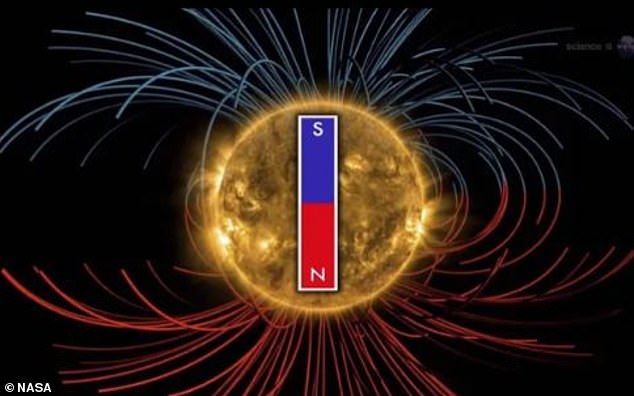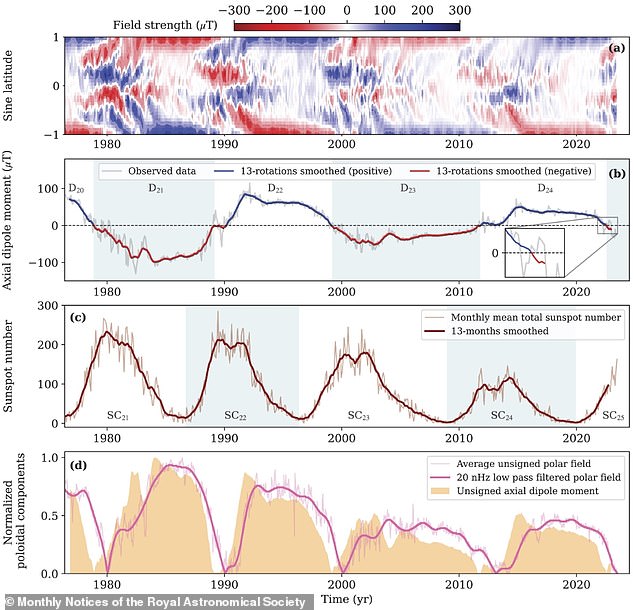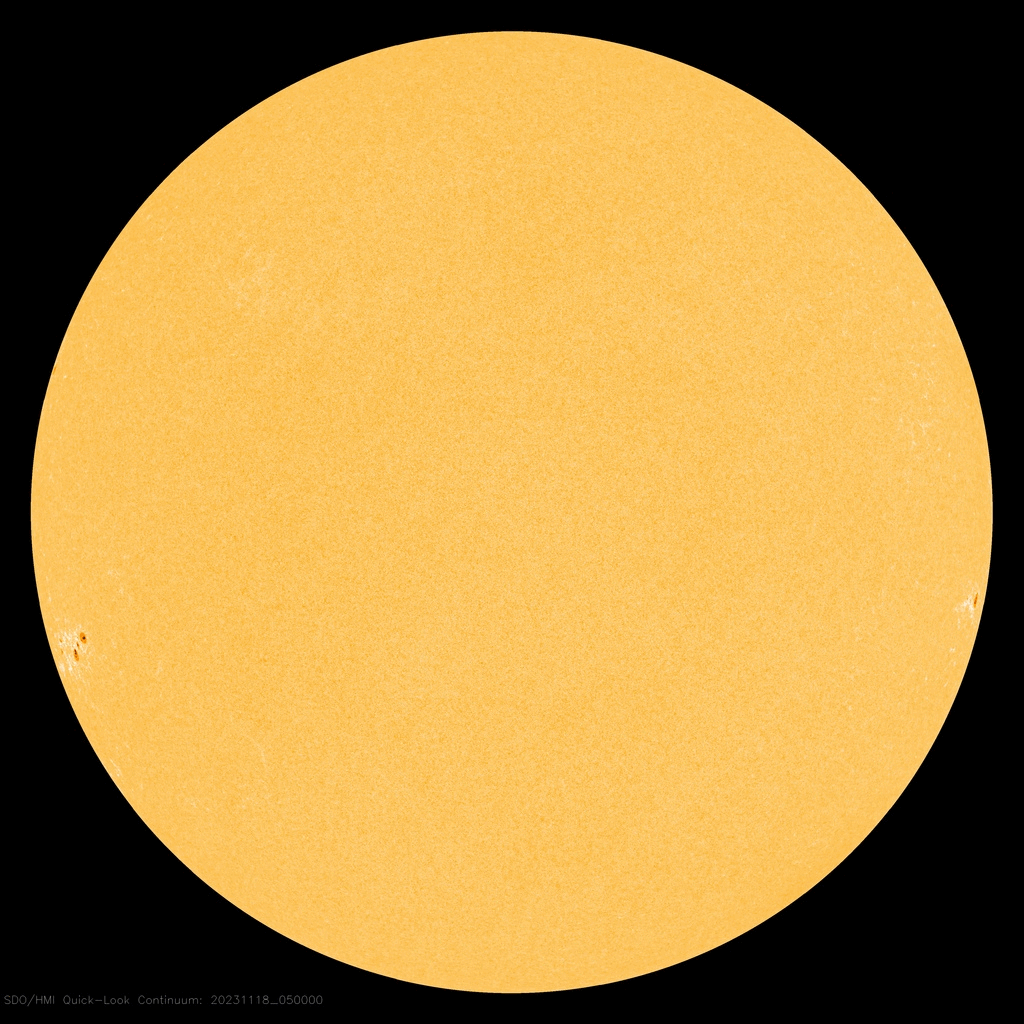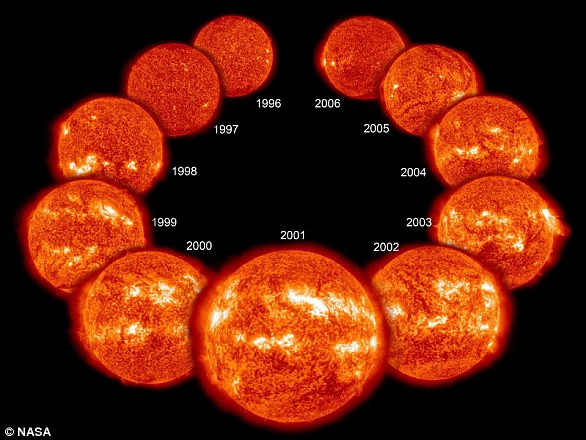Earth will be bombarded by intense solar storms next YEAR: Scientists predict we’ll reach ‘solar maximum’ in 2024 – with flares strong enough to cripple the world’s internet for WEEKS
About every eleven years the sun goes through a so-called ‘solar maximum’, during which many bizarre dark spots appear on its surface.
These ‘sunspots’ – which can clump together to form something resembling an archipelago – are caused by massive changes in our star’s magnetic field.
They also shoot violent energy blasts towards Earth, creating ‘solar storms’ that could potentially damage satellites and disrupt the internet.
Unfortunately, a new study shows that this solar maximum will come sooner than expected – most likely in early 2024.
The new prediction comes from an Indian team of researchers and is in stark contrast to NASA’s latest prediction expects its arrival at the end of 2025.
Researchers have discovered a new relationship between the sun’s magnetic field and the sunspot cycle, which could help predict when the peak in solar activity will occur. This image from the Solar Dynamics Observatory shows the Sun with multiple sunspots, which appear dark compared to their surroundings.
The new study was led by Dr. Dibyendu Nandi, a physicist from the IISER Kolkata Center of Excellence in Space Sciences in India.
He said it is “not possible to predict the intensity and impact” of solar storms this early, but that we should learn more as the new year approaches.
‘The most intense storms can sometimes result in catastrophic orbital decay of low-Earth orbit satellites, disrupting satellite-based services such as communications and navigation networks,’ he told MailOnline.
‘They can also cause strong disturbances in the geomagnetic field, knocking out power grids in high latitudes.
“Of course, they also create beautiful auroras, so we can expect 2024 to be a good year for auroras hunters.”
Dr. Nandi and his colleagues have managed to come up with a new way to detect solar maximum, but understanding it requires some basic knowledge about our solar system’s life-giving star.
The sun is a huge ball of electrically charged hot gas that moves and creates a powerful magnetic field, officially known as the dipole field.
This dipole field – which extends from one pole of the Sun to the other, just like Earth’s – goes through a cycle called the solar cycle.
About every eleven years, the sun’s magnetic field completely reverses, meaning the north and south poles switch places.

Every 11 years, the Sun’s magnetic dipole field (which extends from one pole of the Sun to the other, just like Earth’s) completely reverses, meaning the Sun’s north and south poles switch places.
This solar cycle affects activity on the Sun’s surface, including the dark sunspots caused by the Sun’s magnetic fields.
One way scientists can track the solar cycle is by counting the number of sunspots and exactly when they appear, usually with the help of satellites.
The beginning of an eleven-year solar cycle, when the Sun has the fewest sunspots, is known as solar minimum, but over time the number of sunspots increases.
The middle of the solar cycle is solar maximum, when the Sun has the most sunspots.
The most violent space weather is expected during this solar maximum.
The researchers say it is a challenge to predict exactly when this peak will occur – and therefore when the most violent space weather will hit Earth.
We know that solar cycles last about every eleven years – but this is just an average, explains Dr Nandi.
‘Eleven years is an average periodicity, which implies that this is determined by averaging the individual periods of all observed solar cycles in modern times,’ he told MailOnline.
‘Individual cycles can vary in length from nine to fourteen years.’

The scientists show how observations of the rate of decay of the Sun’s dipole magnetic field can be usefully combined with observations of sunspots to predict when the ongoing cycle will reach its peak. Their analysis suggests that the maximum of solar cycle 25 is likely to occur in early 2024
Scientists already rely on clues collected by Swiss astronomer Max Waldmeier nearly 100 years ago to make the best estimates of when solar maximum will arrive.
In 1935, Waldmeier discovered that the faster the rise of a sunspot cycle, the stronger its force.

In the photo the Swiss astronomer Max Waldmeier, responsible for the Waldmeier effect
Therefore, as Waldmeier explained, stronger cycles – that is, with more sunspots – take less time to reach their peak intensity.
This relationship – known as the ‘Waldmeier effect’ – is often used to predict the strength of a sunspot cycle based on observations of its early rising phase.
What the Indian researchers have done is find a new relationship, using decades-old data archives from multiple ground-based solar observatories around the world.
The rate at which the Sun’s dipole magnetic field decreases is also correlated with the rate at which the sunspot cycle is underway.
‘The Sun’s dipole field increases and decreases roughly in phase with the sunspot cycle,’ Dr Nandi told MailOnline.
‘During the minimum of the solar cycle, when almost no sunspots are observed on the Sun, the dipole field strength is maximum.
‘As the sunspot cycle begins to increase, the Sun’s large-scale dipole field begins to weaken and adopt a more complex configuration.

This 24-hour movie from NASA’s Solar Dynamics Observatory shows sunspots on November 18
‘The dipole field disappears during the peak of the sunspot cycle and then it changes direction and starts to grow slowly again.’
Scientists used their new knowledge to predict exactly when the current cycle’s solar maximum would reach its peak – in early 2024.
“Predicting the time of the maximum amplitude of the sunspot cycle is important to measure when the most adverse environmental conditions in space (space weather) are expected,” they say in their paper.
The new research appears in Monthly notices of the Royal Astronomical Society.

